- Submissions

Full Text
Archaeology & Anthropology:Open Access
Hierarchy Amongst Rocks of Sausar Group - Evidences from Seoni-Balaghat Area, Madhya Pradesh, India
DC Banerji*, S Majumder, RK Shrivastava, M Fulmari and AK Basu
Renaissance Township, Burdwan, India
*Corresponding author: DC Banerji, Renaissance Township, Burdwan, India
Submission: October 14, 2019Published: October 30, 2019

ISSN: 2577-1949 Volume2 Issue4
Abstract
The Proterozoic rocks of Sausar Group, comprising a pack of metasedimentaries and biotite gneisses, are subject of debate from the beginning. Presence of similar rocks as enclaves within the basement gneisses, and also within the cover sediments of Sausar Group is mind boggling. In absence of undoubted sedimentary structures, erection of stratigraphic column of the Sausar metasedimentaries, leaves ample scope of reasonable doubts.
Selective association of the debatable conglomerates with mylonite zones, along with stretching, boudin aging and rotation of the hydrothermal emplacements along these mylonites are suggestive of the formation of autoclasts, deceiving for sedimentary conglomerates. The granitic/gneissic pebbles of these autoclastic conglomerates are the stretched and rotated boudins of the pink feldspar bearing quartzofelspathic emplacements. Biotite gneisses, including Tirodi biotite gneiss and the Junewani gneiss, are products of synkinematic emplacement of huge mass of white feldspar bearing granitic material within pre-existing carbonate dominated sediments. Enclaves of granulites occuring within the biotite gneiss represent ‘skarns’, derived metasomatically from the peripheral part of the Sausar metacarbonates. Both the varieties have identical mineralogy and chemical composition. Further granitization of these skarns/ granulites produce ‘biotite granulites’, ‘hornblende gneiss’ and ‘calc-silicate gneisses’, depending upon the degree of assimilation. The pink feldspar magmatism during late D1 deformation is manifested as widespread quartzo-felspathic activity, especially along the available weak zones, and occasionally form small stocks of pink foliated granite. Boron metasometism and greissening associated with the pink magmatism is responsible for replacement of feldspars by tourmaline and muscovitization/sericitization of the feldspars respectively, producing tourmaline bearing quartz-muscovite schist/gneiss along the periphery of such emplacements. The Sausar metamorphites and the gneisses of the area, therefore, are the products of granitic activity within the largely carbonate rich sediments. It is thought provoking, therefore, if these rocks are amenable to stratigraphic hierarchy.
Keywords: Autoclastic conglomerate; Metacarbonates; Metasedimentaries; Synkinematic emplacements; Skarns; Granulites; Calc-silicates; pink magmatism; Greissening
Introduction
Geology of Sausar Group of rocks, extending from Chhindwara district of Madhya Pradesh, in the west, to Balaghat district, in the east, and possibly continuing beyond, is interesting for encompassing majority of the manganese deposits of the world. Sir Fermor [1], through a series of publications between 1904 and 1909, brought out a detailed account of his “Sausar Series” (phyllite, schists, gneisses, crystalline limestone/marble and calc-silicates/granulites and associated manganese ore deposits) of Central India. The stratigraphic succession suggested by Fermor (op.cit) and improved upon by West (1936, in [2]) and later by Naryanaswami et al. [3] is largely accepted for the gneiss and schist belt of Sausar group of Central India.
West (op.cit) was of the opinion that the gneisses of Sausar Group are composite in nature and are produced by the intrusion of igneous material either into the pre-existing igneous rocks or into the metamorphosed sediments belonging to Sausar Group. Straczek et al. [4] included these migmatitic gneisses within the Sausar group, as the basal member, and named them “Tirodi biotite gneiss”. Narayanaswami et al. [3] (op.cit) and Shukla & Anandalwar [5], however, considered the “Tirodi gneiss” to be the basement for the Sausar Group, having a disconformity between the two.
However, the entire stratigraphic column erected for Sausar group is never witnessed at any single location. Furthermore, the rocks being metamorphic in nature, neither the pres- ervation of primary sedimentary structures indicating direction of younging is expected, nor has been taken support of while allotting hierarchy between the different sub-groups (Formations).
Origin of the conglomeratic rocks present at many locations at the contact between biotite gneiss and Sausar metasediments is debatable and remains unresolved till date. Mohanty [6], nevertheless, has suggested that the conglomerate forms the basal unit of Sausar Group in Mansar area of Maharashtra, India.
Ambiguity prevails, also, about the origin of calc-silicates/granulites occurring along the periphery of Lohangi and Bichua metacarbonates, and also within the Tirodi biotite gneiss. Pascoe (op.cit) refers to the fact that in strike continuity calc-granulites grade into marble, through banded calciphyres. Subramanyam [7] observed that at many a places amphibolites (of supposedly igneous origin), present in the western part of Balaghat (toposheet 55 O/10), have a gradational relationship with calc-silicates/granulites and they could be metamorphic variants of marbles and/or calc silicates. Naryanaswami & Venkatesh [8], also, have reported about the lateral grading of Lohangi marble into the calc gneisses, and about the presence of these calc gneisses within the Tirodi biotite gneiss of the surrounding area.
Banerji et al. [9], based on their observations of cross cutting relationship between the foliation of the country rock and the associated manganese ore bodies in Bharweli and Tirodi area, have proposed an epigenetic origin for the manganese deposits, being later to the Sausar sedimentation. Banerji et al. [10], have also reported contact metamorphism of the Bichua metacarbonates of the Sausar Group from the western part of Balaghat, Madhya Pradesh. According to them, causative body for making the Bichua rocks thermally metamorphosed is Tirodi Biotite gneiss. This paper, thus, analyses the field evidences from Balaghat and Seoni districts of Madhya Pradesh, to ascertain if the present hierarchy allotted to the rocks of Sausar Group warrants reconciliation.
Geologic Setting
The rocks of the Sausar Group have been sub-divided (after [3]), in ascending order, into a basal Sitasaongi quart-muscovite schist and gneiss Formation, followed upward by Lohangi marble and calc-silicate/granulite/gneiss Formation, Mansar phyllite and muscovite schist/gneiss Formation having manganese horizon at bottom, middle and top of the formation, Chorbaoli quartz-muscovite schist/gneiss and quartzite Formation, Junewani biotite-muscovite schist/gneiss and biotite granulite Formation and the youngest Bichua marble and calc-silicate Formation (Figure 1). Naryanaswami et al. [3] (op.cit) has considered the Tirodi biotite gneiss to be the basement for the Sausar Group and the contact between the two has been taken to be disconfirmable. Phadke [11], however, has favoured emplacement of large scale anatectic melts into the Sausar metasediments, producing granitic gneisses.
Figure 1:Geological sketch map of Sausar rocks of Balaghat-Seoni area (after Banerji et.al., 2007).

Figure 2:Calc-silicate ghosts within biotite gneiss.

Lithological Observations
Biotite gneiss
The most extensively occurring group of rocks in this part of Madhya Pradesh is ‘Biotite gneiss’, encompassing several textural and mineralogical variants. The ever-changing nature of these biotitic gneisses makes it impossible to delineate them separately as individual litho-types. The variation in mineralogy and texture is essentially caused by the presence of innumerable bands/patches of calc-silicates of variable mineral composition and their further digestion. Nearer to the belt of Mansar Formation (Figure 1), these calc-silicate bands/patches are dominated by mineralogy of green schist facies. Progressively away from the Mansar belt, calc-silicates represent amphibolite and pyroxene granulite facies [10]. These calc-silicate bands also show different degree of assimilation within the biotite gneiss. In the farthest area from the metasedimentary belt i.e. to the extreme north, degree of assimilation is maximum with the calc-silicates left as ghost structures (Figure 2) within the monotonous gneissic terrain. The gneiss is mafic rich adjacent to the enclosed calc-silicates. Often, the mafic minerals of the calc-silicates get retrograded on assimilation, acquiring amphibolitic composition. The characteristic granulose texture of the calc silicates is also retained in the patches where the interaction is metasomatic.
Additionally, emplacements of pink feldspar bearing quartzo- felspathic material of variable dimensions cause felspathization of the biotite gneiss with epidotization and enrichment of white mica and garnet along the bordering zones. At many places felspathic mica schists are developed along pink pegmatite bodies. Quartz, muscovite and sericite are main constitutents of these schists with minor amounts of epidote, chlorite, tourmaline, actinolite, garnet and at places fibrolite. Northern extension of the Tirodi manganese mines exposes best example of such schists.
The biotite gneiss is generally coarse, streaky, banded, granulose and equigranular in nature. Biotite is most dominant mafic mineral, though hornblende, in the bordering zones of ghost structures, is also not uncommon. Oligoclase/andesine is the dominant feldspar comprising the gneiss with quartz and accessory amount of biotite along with muscovite, chlorite, epidote and garnet. Orthoclase, perthite and microcline feldspars are also common nearer to pink quartzo-felspathic emplacements. Migmatitic structures are very common along with agmatic, stromatic, lit-par-lit, ophthalmic and dilation structures. Opthalmic structures are product of pinch and swell mechanism acted on layers of quartzo-felspathic material (Figure 3) producing pseudo-augens. Subhedral, smaller (2-3cm), equant feldspar crystals produce porphyritic texture.
Figure 3:Pseudo augens produced by pinch and swell mechanism within paleosomatic biotite granulite.

The Tirodi biotite gneiss, in existing literature, is known to enclose amphibolites, calc-silicate/gneiss and quartz-biotite granulites. Added to that, presence of metacarbonate in core part of calc-silicate raft, enclosed within biotite gneiss, is reported in the subsurface data of Bawantheri dam foundation [10]. In addition, amongst many others, mention of enclaves of metacarbonates in the biotite gneiss of western part of Balaghat can also be made, occuring 1km ESE of Piparwani (21°39’: 79°34’), and at Pulpula (21°41’: 79°33’). In the eastern part of Balaghat, a nala section near Newargaon (22°02’: 80°08’), located on the Charegaon-Lamta road, also exposes metacarbonate enclave within biotite gneiss. In all such locations, metacarbonates occur in association with a rim of calc-silicate. Also, a review of the geological map (Figure 4) presented by Banerji et al. [10] clearly shows the presence of plenty of smaller metacarbonate rafts within biotite gneiss, in vicinity of the major metacarbonate bodies belonging to Bichua Formation.
Thus, it is quite enigmatic that the basement gneiss (Tirodi biotite gneiss) encloses representatives of all the major rock types, constituting the cover sediments of Sausar Group, known to be resting over it. The difference between the enclaves of metasediments and the similar cover sediments is never dealt with in the existing literature. However, in this context, the view of Dr WD West in [2] that the gneisses of Nagpur-Seoni area are produced by the intrusion of igneous material into the metamorphosed sediments of Sausar Group, appears to be more pertinent.
Banerji et al. [10] describes a linkage between metacarbonates of Bichua Formation of western part of Balaghat and the calc-sili cates present in its peripheral part, and also within the surrounding biotite gneiss. They referred the calc-silicates as ‘skarns’ formed by thermal interaction between the Bichua metacarbonates and the enclosing biotite gneiss. The thermal interaction between them obviously implies advancement of hot granitic melt, in synkinematic conditions, producing biotite gneiss. The biotite gneiss is richer in accessories like actinolite, tremolite calcite/dolomite and cummingtonite near metacarbonate contacts, and encloses patches of metacarbonates as well as partly assimilated calc-silicates. Mineralogy of these calc-silicates makes them resistant to assimilation, and thus, making their presence more frequent and widespread within the biotite gneiss. At places, these resistant calc-silicate bodies retain metacarbonates in their core part, having helped in escaping assimilation. The metacarbonates, on the contrary, without the rim of calc-silicates, get assimilated easily and, therefore, lack larger distribution within biotite gneiss and are restricted only near to the bigger rafts.
Figure 4:Geological map of part of topo sheet 55 O/10 [9].

The biotite gneiss has a gradational relationship with all the varieties of metasedimentaries. Thus, it is the biasness of the observer, having a preconceived idea of existence of a basement gneiss, which differentiates the gneisses present in vicinity of metasedimentary bands and showing gradational contacts and having caught-uppatches of the nearby metasediments, as Junewani gneiss. Workers like Subramanyam [7], therefore, have considered the biotite gneisses of Ramrama and also of the northern part of toposheet 55 O/10 where the gneisses adjoining the metacarbonate bands show a gradational contact and also include calcic bands within it, as belonging to Junewani Formation.
Analysis of biotite gneiss collected from different locations of western part indicate that the gneiss has abnormally high values of CaO and MgO (23.40% and 18.30% respectively) and correspondingly low SiO2 and Al2O3 (34.53% and 5.44% respectively) values near the metacarbonate contact (sample No. 8). The biotite gneiss, in general, analyses higher values of CaO and MgO and higher ratio (2:1) of K2O/Na2O (Table 1).
Table 1:Chemical analysis of biotite gneiss from 55 O/10.

Metacarbonates
The Sausar meta-carbonates of the Seoni – Balaghat region have best representation near the western border of Balaghat district, and continuing into Seoni, where a number of mapable bands of meta-carbonates, belonging to Bichua Formation, are exposed in a surrounding of biotite gneiss (Figure 1). Elaborate descriptions of these bands are available in a recent paper by Banerji et al. [10]. These greyish-white to white meta-carbonates are predominantly dolomitic, showing strong thermal effects in the peripheral part. Dark coloured patches, rich in minerals like diopside, augite, hornblende, and epidote with accessory amount of quartz, bytownite/ andesine, sphene and apatite with a characteristic granulose texture, occur at many places in the peripheral part of the meta-carbonates. Formation of these calc-silicate minerals appears to have taken place as metasomatic replacement of the carbonates, thereby retaining the original granulose texture and is referred as ‘skarns’ [12].
Figure 5:Development of chondrodite and spinel along quartzo-felspathic veins in metacarbonate.
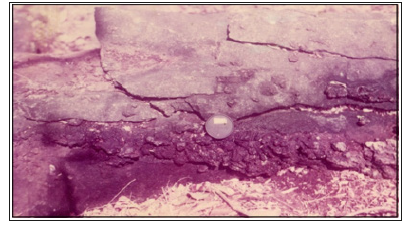
The meta-carbonate periphery, other than having calc-silicate skarns, also show presence of minerals like chondrodite (an humite, resembling garnet in hand specimen) and spinel in association with forsterite, diopside and at places, wollastonite and scapolite, as disseminations, especially in vicinity of quartzo-felspathic intrusives (Figure 5). These minerals are known as products of contact metamorphism of impure dolomitic limestone [13]. Thus, in sizeable metacarbonate bands, like the ones occurring near Hathigarh- Ambajhiri or Piparwani-Dhobitola and Paraspani-Pitesur area (Figure 4), the outer 250m is rich in higher temperature mineral assemblage represented by calcite-dolomite-forsterite (partly serpentinized)- diopside-chondrodite-spinel-tremolite, constituting a greyish-white marble, and by diopside-augite-hornblende-epidote with quartz, calcic plagioclase, sphene and apatite constituting darker calc-silicate skarns. The higher temperature mineral rich zone is followed inward, for around 500m, with a zone rich in calcite- dolomite-diopside-tremolite-biotite-white mica-spinel assemblage. This zone is devoid of any calc-silicate skarns. The medium grained, greyish-white marble of this zone has local development of gneissic structures formed by alignment of biotite flakes. The core parts of the meta-carbonate bands comprise low temperature assemblage of calcite-dolomite-tremolite-white mica and chlorite, constituting fine grained, greyish-white marble.
In vicinity of the bigger meta-carbonate bands, several smaller metacarbonate and calc-silicate lenses are embedded within the surrounding biotite gneiss. One such metacarbonate band (0.75km x 0.5km) is exposed in a nala section, south of Kharparia (21° 41’: 79° 42’), having concordant, thicker (5m), bands of pink feldspar bearing quartzo-felspathic material with innumerable thin quartzo- felspathic (pink feldspar) veins emplaced on laminar scale. Because of fine dissemination of pink feldspars (felspathization) all through the body, the meta-carbonate body acquires pink colouration. Also, presence of quartzo-felspathic veins on laminar scale imparts a banded nature to the rock. Stretching and boudinaging of the thicker veins indicate existence of a compressive regime, facilitating emplacement of quartzo-felspathic material and subsequent production of pinch and swell structures (Figure 6). It is necessary to mention the presence of another small metacarbonate lens, 250 m west of the pink body, devoid of pink quartzo-felspathic emplacements, has a gray colour like all other meta-carbonate bodies of the area.
Figure 6:Exposure of pink metacarbonate in Dhoriya Nala, near Kharparia.

Figure 7:Photomicrograph of metacarbonate from Gomji Somji Pahar showing alignment of carbonates. Crossed nicols, X32.

Figure 8:Autoclastic conglomerate of Gangulpara. Note the differential weathering of the matrix.
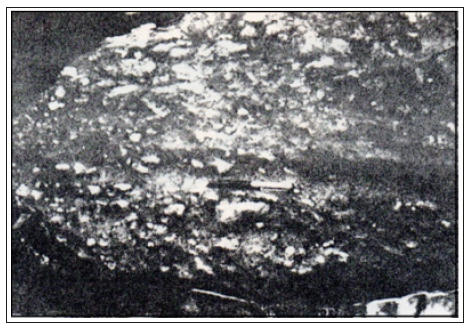
It is also evident that the pink metacarbonate lenses exposed in other localities as well, like the one exposed at the northern extremity of Gomji-Somji Pahar (21° 52’ : 79° 15’) and the other at Gangulpara (21° 54’ : 79° 17’), located in the eastern part of the belt, are invaded by pink quartzo-felspathic material accompanied by shear deformation. Ductile shearing of the metacarbonates is well documented by preferred orientation of the constituent carbonate minerals (Figure 7). Local development of crush conglomerates, characterised by stretched and rotated autoclasts of vein quartz and quartzo-felspathic material with sericitic wrapping and a calcareous matrix (Figure 8) are common at both the places. Formation of autoclastic conglomerate exemplifies prolonged ductile/ brittle-ductile deformation. Incidentally, a small grey coloured meta-carbonate lense, devoid of pink feldspar bearing quartzo-felspathic bands, is exposed in Wainganga Canal section, 500m NW of Gomji-Somji Pahar. At all these locations, meta-carbonate bodies are located within a surrounding of Mansar phyllite. The contact between the meta-crbonates and the phyllite is gradational.
Calc-silicates
Calc-silicates are the second most abundant rock type, occurring as lenses of variable dimensions within the biotite gneiss. In addition, as discussed earlier, calc-silicates also constitute an integral part of the outer rim of the meta-carbonates. Lateral, as well as across the strike, grading of calc-silicates (belonging to Lohangi and Bichua Formations) into biotite gneiss/biotite schist and to meta-carbonate has been discussed by all the previous workers. Nevertheless, the relationship between the calc-silicates associated with meta-carbonates and the ones present within Tirodi biotite gneiss has never been resolved, though doubts have been raised by some of the workers about their being different. The major hindrance in establishing inter-relationship is the considered opinion of Tirodi biotite gneiss as basement for the Calc-silicate bearing Formations.
The calc-silicates are light to dark green or greyish green in colour, medium grained, and have a characteristic granulose texture. Banding, resulting from alternate bands of quartzose and mafic minerals, is common in the southern calc-silicates present near to the belt of Mansar phyllite (Figure 1), whereas, massive variety is dominant within the main gneissic body, present to the north. The banded variety is often associated with angular folding (Figure 9), indicating effects of shear-deformation.
Figure 9:Angular folding in banded calc silicate. Loc Bawantheri river, near Sitekasa.

Calc-silicates of meta-carbonate periphery, as well as those present within the biotite gneiss, show a gradational contact with the biotite gneiss, often having a hybrid zone of assimilation in-between. As discussed elsewhere, the contact with meta-carbonates, wherever present, is also gradational. With diminishing carbonate contents and increase in mafics (silicates), meta-carbonates grade into calc-silicates. Exposures of calc-silicate lenses with meta-carbonate core, as present at a few places within the biotite gneiss terrain of Babai (21° 44’: 79° 32’), best exemplify gradational nature of the contacts.
The calc-silicate lenses/bands have a variable mineralogy from south to north (Figure 1), having best representation in the western part. Calc-silicate bands of the south are dominated by the assemblage hornblende-quartz-bytownite/andesine-chlorite and epidote with accessory amount of sphene, apatite and calcite. In the banded variety, quartzose bands include quartz, microcline, perthite and oligoclase with minor amount of epidote and hornblende, whereas the mafic bands comprise hornblende, epidote, diopside and bytownite with minor amount of oligoclase, microcline, chlorite, sphene, apatite and calcite. The contact between the two compositional bands is never sharp. Lateral as well as across the width grading of banded calc-silicate to the massive variety is also common amongst the calc-silicates of southern part.
From the arrangement of mineral assemblages in calc-silicates, it is obvious that the southern lenses, comprising hornblende-epidote- chlorite-quartz-bytownite, represent low to medium grade of metamorphism with an increasing trend towards north. Thus, the Diopside-zoisite bearing assemblages dominate in the calc-silicates of further north, and with the disappearance of Zoisite, to the extreme north, the calc-silicates are predominantly diopside and/or augite bearing. Though, hornblende is persistently present throughout the area, they appear to be after pyroxenes in the northern lenses. Also, line of first appearance of diopside is not very sharp as some of the calc-silicate lenses of the southern part show presence of diopside along with hornblende and epidote, much before the first appearance of zoisite.
It is noteworthy to mention that these calc-silicates are also present south of the belt of Mansar phyllite, especially in Balaghat area, and has been variously termed as ‘granulites’ and ‘basic intrusives’. However, these granulites or the basic intrusives are compositionally (chemical and mineralogical) very much akin to the calc-granulites of north, and also include the banded variety, as exposed south of Dongargaon (21° 43’: 79° 06’), south of Mendki (21° 42’ : 79° 06’) and at Bagarmata (21° 38’: 79° 14’). Nevertheless, as the purpose of the paper is to highlight interrelationship between the different lithotypes of Sausar Group, correlation of the Sausars with the rocks present to the south of the metamorphic belt is excluded from its purview.
Banding in calc-silicates (Figure 10) are comparable with the quartzo-felspathic banding of the meta-carbonate of Kharparia. Quartzose bands, like in meta-carbonate of Kharparia, are the manifestation of lit-par-lit injection of pink feldspar rich quartzo felspathic material along the shear generated weak planes, within the calc-silicates. Stretching of quartz and feldspars is a common phenomenon in such bands. Prolonged shearing along such zones often has resulted in production of angular folds, and also has caused incremental influx of quartzo-felspathic material. However, direct transformation from banded metacarbonate to banded calc-silicate, in a regime of prolonged shearing, also can’t be ruled out.
Figure 10:Exposure of banded calc silicate in Bawantheri river, near Sitekasa.
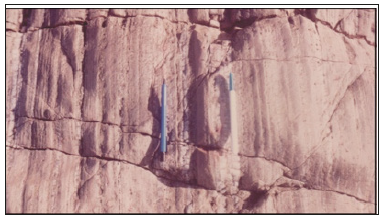
In the gneissic terrain of far north, the calc-silicate lenses are smaller in dimension and often show assimilation within the biotite gneiss, aided by dilation (Figure 11). Such dilated calc-silicate bodies are further assimilated by anastomosing quartzo felspathic material (Figure 12), rendering the rock into a migmatite. Feldspars associated with such zones are oligoclase and andesine, in contrast to the microcline and perthite of the banded calc-silicates of southern part.
Figure 11:Dilation of calc silicate. Loc North of Babai.

Figure 12:Dilation structures with ramifying quartzo felspathic intrusions.

Biotite granulite/schist
This unit, like the calc-silicates, has a wide distribution within biotite gneiss but very rarely reaching to a dimension of mapable unit. Mapable band of biotite schist/granulite occur at few locations like (a) in Bawantheri River, north of Sitekasa (21° 32’ : 79° 33’), (b) 1.5km north of Bawantheri village (21° 49’ : 79° 35’) and (c) north of Dhapewara (21° 54’ : 79° 11’). At all these locations the biotite schist has a gradational contact with biotite gneiss. Most of the workers have also recognised the biotite schists to have gradational contact with the biotite gneiss. Shukla & Anandalwar [5] have recognised presence of a thin zone of felspathised biotite schist, occupying the transitional zone between the quartz-muscovite/sericite schist/phyllite and grading into biotite gneiss, in Polwattur (21° 60’: 79° 17’) area. Extension of this zone is also recognisable further SW, near Dhapewara, where sericite phyllite of Bharweli-Ukwa belt grades to biotite schists and with further increase in quartzo-felspathic material, grades to biotite gneiss.
Figure 13:Development of biotite schist and gneissic structures within metacarbonate.
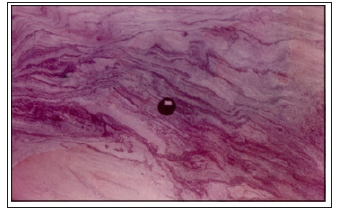
The biotite schist/granulite of Sitekasa area is NE-SW trending elongated body, sharing the southern contact with calc-silicate and the northern contact is shared with biotite gneiss. The rock also grades laterally to biotite gneiss. However, within the biotite schist, lateral grading to calc-silicate or vice-versa is also evident. In most part, the rock is highly crenulated and tightly folded in angular pattern (having straight limbs and sharp hinges), indicating effects of compression. Often, small lenticles of calc-silicates occur in the closure part of these minor folds. Towards the contact with calc-silicate, the rock is medium grained, harder owing to the presence of plenty of feldspar grains, saccharoidal, and grades to calc-silicate. In the central part, it is coarse grained and flaky, having profuse development of biotite flakes. Near the gneissic contact, the rock is felspathised, and with the increase in grey feldspar bearing quartzo- felspathic veins, biotite schist grades to biotite gneiss.
Streaks of biotite schist is also present within metacarbonates near Agri (210 38’: 790 33’) and near Bavli (210 39’ : 710 30’). In the marble quarry located near Agri, biotite schist patches within marble are less than a metre thick and extend laterally for few metres. In Bawantheri River section, near Bavli, biotite streaks occur within metacarbonates (Figure 13) near the contact with biotite gneiss. Contact metamorphic minerals like chondrodite and spinel are also common within metacarbonate, a few metres from the biotite streaks. Thickness of the biotite rich streaks increases locally to become calcareous biotite schist. With the direct invasion of quartzo- felspathic material, near the contact, the rock grades to felspathic biotite schist, and finally to biotite gneiss.
The biotite schist/granulites comprise quartz, biotite and oligoclase/ andesine, with minor amount of apatite and opaques. In metacarbonate hosts, accessory amount of calcite, tremolite and sphene is also common. Two generations of biotite, the earlier being dark brown clots with faint pleochroism, are also common of these rocks. A granulose texture defined by equigranular quartz and feldspars, is common towards its contact with calc-silicates. Thus, the biotite granulites are the retrograded products of calc-sil icates. However, the biotite schists of the transitional zone present at phyllite/biotite gneiss contact or at metacarbonate/biotite gneiss contact are products of progressive metamorphism.
Pink granitoids/pegmatoids
Innumerable pink feldspar bearing pegmatoids of different dimensions, having both concordant and discordant relationship with widespread felspathisation of the country rock, characterise the area. At few places, however, these pegmatoids grade to small, linear, bodies of pink granite. Peripheral part of the granitic bodies, as well as the pegmatoids, is markedly sheared, as evidenced by the stretching of quartz and feldspars and alignment of muscovite/ biotite. Widespread felspathisation of the country rock and development of quartz-muscovite/sericite schist with ribbons of quartz and pink feldspar along the periphery is also characteristic of these bodies. Thickness of the schistose rock is directly proportional to the thickness of the granitoid/pegmatoid. Mapable bodies of the pink granite are exposed at places like a) 3 km south of Baputola (21° 53’ : 79° 44’), b) 2km north of Sakata (21° 49’ : 79° 40’), c) near Dhobisarra (21° 56’ : 79° 37’), and d) in Wainganga river section NW of Dhapewara (21° 54’ : 79° 11’), 1km south of Wainganga bridge located on Balaghat - Waraseoni road and 1km north of Pipariya (21° 48’ : 79° 15’). The quartz-mica schist is even developed within metacarbonate bands, when traversed by a pegmatoid, as exemplified at few places like west of Ambajhiri (21° 37’: 79° 35’), in Job Nala [on Tirodi - Khawasa road, 2km east of Piparwani (21° 40’ : 79° 34’)], at the northern extremity of Gomji-Somji pahar (21° 52’ : 79° 15’), near Gangulpara (21° 54’ : 79° 17’) and south of Polwattur (21° 60’ : 79° 17’). The granitic bodies comprise quartz, orthoclase, microcline, perthite and biotite/muscovite with minor amount of epidote, hornblende and opaques. Increased amount of epidote and hornblende occurs when the granitic body is in contact with calc-silicate. The peripheral part of pink granite shows development of mylonitic foliation (Sm) parallel to its margin.
A distinct layered arrangement of quartz and feldspars is characteristic of the pink feldspar pegmatoids. The concordant bodies are markedly sheared and greisened and are represented by muscovite- sericite-altered feldspar and at places fibrolite rich periphery and a well cleaved quartzose core. The strong, mylonitic foliation present in the peripheral muscovite/sericite rich zone often renders the rock as felspathic schists. The well cleaved quartzose core, at many places, deceives for quartzite. However, presence of well-shaped and oriented crystals of tourmaline, as clusters, along fracture planes of quartz (Figure 14) represent more of boron metasometism, and alteration of feldspars to mica (Figure 15), in peripheral part, further represent phenomena of greisening. High values of niobium and tungsten in such rocks (Table 2) support for their epigenetic origin.
Table 2:XRFS analysis of samples of quartzose core/quartz-muscovite schists.
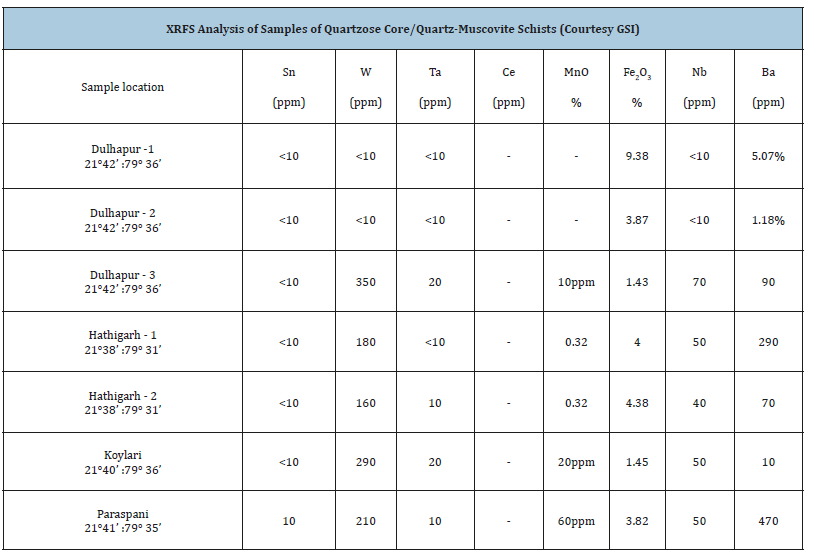
Figure 14:Clots of tourmaline within quartz grains. Plane polarised, X32.
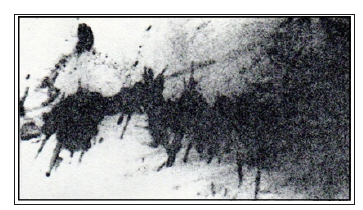
Figure 15:Break down of feldspar (K) into muscovite (m) and quartz (Q). Crossed nicols, X32. Tirodi
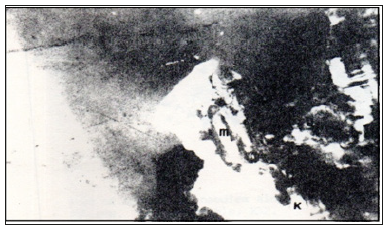
In addition to large scale felspathisation of the country rocks, the pink pegmatoids are also responsible for breaking down of higher silicates into hydroxyl silicates, as is evidenced by enrichment of asbestos in the affected calc-silicates, and by enrichment of muscovite and chlorite along the contact with biotite gneiss. Hydrothermal alteration of calc-silicate, producing asbestos, is best exemplified at 1.5km SW of Heti (21° 34’: 79° 35’) and 1.5km SE of Jamrapani (21° 47’: 79° 35’).
Quartzose core of some of the pink pegmatoids have layers of opaques alternating with quartz. At places even tourmaline occurs as alternating layers with quartz. It is observed that the pegmatites occurring near metasedimentary belt contain layers of manganese minerals whereas the northern pegmatites, occurring away from metasedimentary belt, contain layers of iron oxides.
Quartz-muscovite schist/gneiss
Quartz-muscovite schist/gneiss and quartzite, belonging to Sitasaongi Formation, is known to be present only in the south-western corner of the Figure 1, located 2km north of Bawantheri Dam. The rocks occupy a narrow N-S ridge near Nangdev (21° 34’:79° 35’). Crest of the ridge is occupied by well cleaved opaque rich quartzose unit with thin layers of muscovite aligned along the fissility planes. On either flank, the rock grades to quartz-muscovite gneiss with many patches of sericitised pink feldspars and accessory amount of tourmaline and opaques. With increasing amount of sericite/muscovite, its further grades to quartz-sericite schist with sericitised pink feldspars and biotite near the margins, before finally grading into biotite gneiss. Biotite gneiss, on either side of the ridge, is highly felspathised (pink feldspars), contains good amount of muscovite and shows stretched and boudinaged pink feldspar bearing quartzo- feldspathic veins intruded on laminar scale. Interestingly, a calc-silicate body (30m x 30m), located near the northern contact of the quartz-mica rich unit, is also highly felspathised and shows profuse development of asbestos fibres (3mm-5mm) all through its length and width.
Thin section studies reveal that the central quartz rich unit at the crest of the ridge is comprised of stretched quartz grains with accessory amount of muscovite, opaques and prismatic crystals of tourmaline. Muscovite appears to be after feldspars (microcline/ perthite) and the tourmaline needles appear to be introduced along the fracture planes of quartz. Chemical analysis of the rock shows higher values of MnO, Fe2O3, TiO2 and Ba (8.50%, 3.43%, 0.14% and 230ppm respectively).
Stretching of quartz in quartz-mica schist and stretching and boudinaging of quartzo-felspathic veins present within the biotite gneiss of the contact zone indicate presence of a compressional regime in the area. Geological map of Banerji et al. [10] also shows presence of a mylonitic zone, passing through the area. Felspathisation of the biotite gneiss present at the contact and hydrothermal alteration of the adjoining calc-silicate body, producing asbestos, and higher values of TiO2 and Ba in the quartz-muscovite schist raises doubt about its sedimentary parentage.
Presence of similar rocks with ENE-WSW trend, can also be observed 2 km north and also 1km SW of Hathigarh (21° 38’: 79° 31’), 3km south of Paraspani (21° 41’: 79° 35’), and north of Ramrama Mines. However, the quartz-muscovite schists/gneiss of these locations has been referred to as Chorbaoli Formation (Figure 1) in the existing literature. North of Hathigarh and at Paraspani, the quartz-muscovite schist/gneiss with a central well cleaved quartzose unit shares a gradational contact with Bichua metacarbonates towards south, and the northern contact is shared with biotite gneiss. Near to the contact, Bichua metacarbonate is increasingly rich in serpentine, talc, muscovite and biotite, whereas the quartzose unit is richer in muscovite and biotite with pods of pink feldspar and fibrolite. Muscovite and fibrolite appear to be after microcline/ perthite. The biotite gneiss, present at the northern contact, is felspathised and richer in pink feldspar and secondary muscovite/ sericite and epidote. In the third location, 1km SW of Hathigarh, northern contact of the quartz-muscovite rock is shared with Bichua metacarbonate and the biotite gneiss is present to its south. At this location, in addition to the observations already discussed, small pocket of crush conglomerate is developed at the metacarbonate contact, resulted from boudinaging and detachment of pink feldspar bearing quartzo-felspathic bands. Matrix for the crush conglomerates is calcareous with good amount of sericite wrapping the stretched pebbles of quartz and quartzo-felspathic material.
At Ramrama, similar quartz-mica schist, with the northern contact shared with Lohangi Marble and in strike continuity, to ENE, grading to Junewani biotite schist/ gneiss Formation (Figure 1), has been classified as Chorbaoli Formation. Southern contact of this quartz-mica schist/gneiss is shared with biotite gneiss. These contacts have been interpreted as thrusted in the existing literature. Thambi [14], who carried out regional exploration for manganese, considered the quartz-mica rocks as belonging to Sitasaongi Formation. He further opined that the contacts of the quartz-muscovite schists with the adjoining lithounits are gradational and expressed the possibility of their being metamorphic variants. He also observed a conformable gradational contact of the Tirodi gneiss with the Mansar schists as well as with the calc-silicate rocks of Lohangi Formation. The Lohangi marble, calc-silicates and amphibolites have also been observed by him as grading into one another.
The quartz-muscovite schists of Talabori-Kokma-Polwattur area, located NW of Ukwa, has also been classified as Chorbaoli Formation [6]. These schists are closely associated with well cleaved quartzose rock with muscovite/sericite partings. Local enrichment of tourmaline makes the rock quartz-tourmaline gneiss/schist and quartz-muscovite-tourmaline schist. Tourmaline is also introduced along the fractures of quartz grains and has been considered as pneumatolysed product (Shukla and Anandalwar, op.cit). Towards north, this quartz-muscovite schist is richer in sericitized pink feldspars and grades into biotite gneiss having stretched and boudinaged pink feldspar bearing quartzo-felspathic bands/veins. The biotite gneiss acquires a pinkish colour because of overwhelming presence of pink feldspars. Nearer to gneissic contact, presence of impersistent bands of crush conglomerate with stretched pebbles of quatzo-felspathic and quartz-tourmaline rock, embedded in gritty and sericitic matrix, indicate existence of a compressional regime. Shukla and Anandalwar (op. cit) have also considered this horizon to be of cataclastic origin. Towards south, the quartz-muscovite rock of Chorbaoli Formation shares a gradational contact with Mansar phyllite, having plenty of quartzo-felspathic and quartzose veins near the contact, and the rock grades to pink feldspar bearing sericite phyllite and to phyllite. In strike extension of the quartz-muscovite rock towards SW, near Dhapewara (21°54’: 79°11’), a small mylonitised body of pink granite replaces quartz-muscovite schist. Further SW, the quartz muscovite schist again appears near Bakoda where the well cleaved quartzose core is associated with pockets rich in manganese.
Reference can also be made of a nala section (Job nala), 2km east of Piparwani (21° 40’:79° 34’), where a 10m thick strike parallel pink feldspar pegmatite is exposed, traversing Bichua metacarbonate, for a length of around 100m. Its pegmatitic nature is discernible only at a few places, the rock is otherwise a quartz-muscovite schist/gneiss throughout its exposed length. The metacarbonate along the contact is rich in muscovite, serpentine, chondrodite and biotite. Presence of serpentine and chondrodite is indicative of thermal effect on the country rock.
The above narration of the quartz-muscovite rocks, spread over the entire area, makes it amply clear that these rocks are largely pneumatolysed product, and are always associated with widespread felspathization (pink feldspar) of the adjoining rocks. It is also evident that at all the locations where quartz-mica schists with quartzose core exist, rocks are subjected to ductile / brittle ductile deformation, producing local pockets of crush conglomerates. Stretching of quartz grains is a common phenomenon in these rocks. Association of tourmaline with sericitization/muscovitization of the feldspars represent boron metasometism and greisening (pneumatolysis), as envisaged for the rocks of Talabori-kokma-Polattur area by Shukla and Anandalwar (op.cit). Analytical results (Table 2) of quartz-muscovite shists/gneises of Hathigarh south, Hathigarh north and Paraspani show anomalous values of tungsten (180, 160 and 210ppm respectively), niobium (50, 40 and 50ppm respectively) and barium (270, 370 and 470ppm respectively), uncommon amongst the rocks of sedimentary parentage. Rocks of these locations, like the Nangdev quartz-muscovite rock, also contain higher values of MnO.
Phyllite
A belt of Grey to green phyllite, having a NE-SW trend, with an average width of 7km, extends all along the southern part of the metasedimentary belt (Figure 1). This belt of phyllite is disrupted by biotite gneiss, for a length of about 5km, west of Waraseoni (21° 46’: 80° 02’). Sothern contact of the phyllite is shared with muscovite rich biotite gneiss enclosing many patches of phyllite. Along the contact, between Balaghat and Bharweli, phyllite and muscovite- biotite gneiss is highly crenulated and sheared and is closely traversed by pink feldspar bearing quartzo-felspathic veins. Width of the sheared and crenulated zone is around 0.8km and has been recognised as a mylonite zone [9]. Along with stretching of quartz and feldspars of the quartzo-felspathic veins, rotation of garnets (Figure 16) present within phyllite, with broken margin and ‘S’ trail of inclusions, further support existence of a ductile regime. This mylonite zone continues to further NE, from Bharweli, through Gangulpara to Jagantola, Ukwa and beyond, traversing well within the phyllite and hosts manganese deposits of Bharweli and Ukwa.
Figure 16:‘S’ trails within garnet having broken margins. Plane polarised, X32.
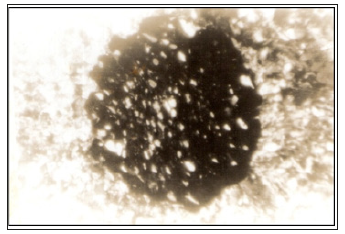
Towards north, with the onset of grey feldspar bearing quartzo- felspathic activity, phyllite grades to biotite schist, and soon grades to biotite gneiss. These biotite schists and gneisses are recognised as belonging to Junewani Formation. When traversed by pink feldspar bearing quartzo-felspathic veins, phyllite becomes richer in sericite and/or mica, pinkish in colour, and show occasional enrichment of brown-red garnet. A hard variety, having enrichment of spindle shaped tiny crystals of ottrelite, occurring closely associated with phyllite as lensoidal bodies, can be identified at number of places, especially around Garra (21°48’: 79°08’) and near Bharweli.
The phyllite comprises quartz, mica, chlorite, biotite and calcite (ankerite?) with minor amout of plagioclase, garnet, sphene, ottrelite, apatite and tourmaline. Presence of ottrelite is more pronounced within the lenses of harder mass. Occurrence of sphene, apatite and tourmaline, likewise, is more near hydrothermal emplacements. Along the mylonite zones, preferred orientation of all the constituents along “S” and “C” surfaces and rotation of garnets with broken margins is reported by Banerji et al. [9].
Crush conglomerate
The conglomerates associated with Sausar belt are subject of debate since inception. Workers have reconciled their opinion towards the origin of these rocks repeatedly, not reaching to a conclusive mandate till date. Two major, impersistent, conglomeratic zones are present in the eastern part of the area. The southern impersistent bodies of conglomeratic rocks follows a mylonite zone well depicted in satelite imagery (Figure 17) as a curvilinear zone, extending from west of Balaghat through Bharweli, Gangulpara, and jagantola, to Ukwa and beyond. This belt is also well represented in the geological map (Figure 1) of Banerji et al. [9] as mylonite zone-I. Conglomeratic rocks are exposed at various places along this belt. Known locations for such rocks are south of Garra; in Wainganga River near the Balaghat bridge located on Balaghat - Waraseoni road; south of Bharweli Manganese Mines; in Gomji-Somji Pahar and near Gangulpara.
Figure 17:Satellite image showing part of the curvilinear mylonite zone extending from west of Balaghat through Manegaon (Bharweli), Gangulpara and jagantola to Ukwa and beyond.
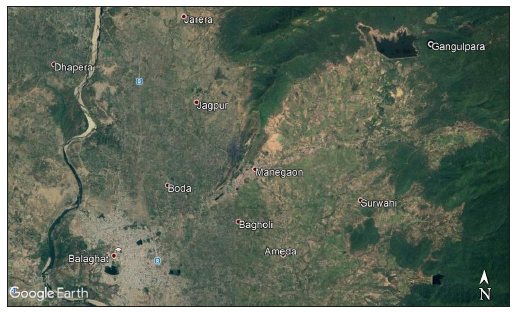
The conglomeratic rock south of Garra, near railway track, has clasts of opaque bearing dark grey quartz, vein quartz and quartz-chlorite-biotite rock embedded in a quartz-chlorite-sericite matrix. This zone lies within phyllite and the quartzose pebbles are clearly developed from pinching, swelling, stretching, boudinaging and rotation of quartz veins. The second and third locations on this belt are on either side of Wainganga bridge near Balaghat and in the southern flank of Bharweli ridge (near Manegaon in Figure 17) respectively, where phyllite is juxtraposed against biotite gneiss. The contact is strongly sheared, silicified and the rocks are invariably granitised. At these locations’ country rock is rich in emplacements of pink feldspar pegmatites and quartz veins along with pebbles of vein quartz, and pegmatoids occuring embedded in quartz-chlorite- mica-feldspar rich schistose matrix. At places chlorite-sericite phyllite also occurs as clasts. Like in Garra, pebbles are resulted from prolonged ductile/brittle ductile shearing, causing pinching and swelling, stretching, boudinaging and rotation of earlier emplaced quartz veins and pink feldspar bearing pegmatites along with recrystallization of layer lattice minerals. The pegmatites and the quartz veins also contain alignment of chlorite, muscovite and rarely biotite drawn from phyllite, as product of assimilation. These pebbles, thus, deceive for pebbles of muscovite/biotite gneiss.
The other locations of conglomeratic rock along this mylonitic zone is at the northern extremity of Gomji-Somji Pahar and near Gangulpara where country rock is metacarbonate and the similar pebbles occur embedded within quartz-dolomite-chlorite-sericite matrix. Some of the pebbles of these locations also contain alignment of epidote and amphiboles drawn from assimilation of carbonates. The northern impersistent conglomeratic band is exposed south of polwattur near Khara (21°58’: 79°16’) and near Kokma (21°59’: 79°16’) and known to continue to further east. The conglomeratic rocks are aligned along zone- IV mylonite of Banerji et al. [9]. The pebbles of vein quartz, quartz-mica schist, pegmatite and of quartz tourmaline rock occur embedded in quartz-muscovite-biotite- sericite rich schistose matrix. Like the southern locations, pinching and swelling, boudinaging, stretching and rotation of the quartzose veins and pegmatoids are responsible for producing pebbles, making the rock autoclastic. Country rock south of Polwattur is a narrow zone of quartz-muscovite-sericite schist with numerous quartzo-felspathic veins, occupying the contact zone between southern phyllite and biotite gneiss present to the north. Felspathisation (pink) of rocks present on either side of the conglomeratic zone is also conspicuous.
Similar to the conglomeratic rocks of Gangulpara and Gomji- Somji Pahar, conglomeratic horizons also occur in Ramrama (21° 50’: 79° 55’) and in Hathigarh area, in the western part of the belt. The Lohangi marble of Ramrama area has localised bands of crush conglomerate near its contact with biotite gneiss. Stretched, boudinaged and rotated pebbles of pink feldspar bearing quatzo-felspathic material and of vein quartz occur embedded in a calcareous matrix rich in dolomite/calcite, quartz, muscovite and sericite. On either side of the conglomeratic horizon, the adjoining lithounits are highly felspathised and traversed by quartzose and quartzo-felspathic veins, showing development of serpentine, muscovite and biotite in Lohangi marble, and pink feldspar and muscovite in Tirodi biotite gneiss.
Small conglomeratic band of Hathigarh is present within Bichua metacarbonate near its southern contact with the biotite gneiss. The pebbles of vein quartz and quartzo-felspathic material are resulted from boudinaging, rotation and detachment of pink feldspar bearing quartzo-felspathic veins traversing the rock at this location. Matrix for this crush conglomerates is calcareous with good amount of sericite wrapping the stretched pebbles of quartz and quartzo-felspathic material.
Manganese mineralisation
Manganese mineralization associated with the Sausar Group is known to occur at three horizons, bottom middle and top of the Mansar Formation, and form major deposits like Ukwa, Bharweli, Ramrama, Tirodi and Sukli-Sitapathore, within the state of Madhya Pradesh. These deposits are considered as metamorphosed syngenetic type based on their association and co-folding with the quartz muscovite schists of Mansar Formation. High temperature manganese oxides like hausmanite, vredenburgite, jacobsite and braunite constitute the major part of these deposits.
Banerji et al. [9], however, proposed for a structurally controlled epigenetic type of origin for these deposits. Their proposal is based on the selective occurrence of these deposits along major mylonite zones identified by them, and also based on the occurrence of high temperature oxide ores with intergrowth texture even in the low grade terrain of Bharweli-Ukwa, and maintaining an angular relationship with the S1 surfaces of the host ‘Mansar phyllite’, and also based on the occurrence of widespread greisening and boron metasometism associated with these manganese ore bodies.
As discussed elsewhere in this paper, quartz-muscovite/sericite schists, with or without manganese mineralization, occurs at many places associated with well cleaved quartzose core. All such occurrences are invariably aligned along one or the other high strain zones, characteristically having a layered arrangement of minerals. The manganese deposits, likewise, also have a quartzose core alternating with layers of manganese ores. Peripheral zones of such quartz-manganese core are occupied by felspathic muscovite/ sericite schists in biotite gneiss/metacarbonate host, and by felspathic sericite-phyllite in phyllite hosts, respectively. Occurrence of the ore bodies in high strain zones is evidenced by stretching and preferred orientation of quartz and opaques along ‘S’ and ‘C’ planes of mylonites and has been dealt with adequately by Banerji et al. [9]. Occurrence of well-developed and oriented crystals of tourmaline, apatite and fibrolite in the ore zones, is also indicative of existence of a stress field. Additionally, occurrence of clusters of tourmalines (Figure 18) along fractures of quartz grains, in all the manganese deposits, is indicative of boron metasometism in these high strain zones.
Figure 18:Clustering of tourmaline needles along fractures of quartz grains. Plane polarised, X32.

Though the ore bodies are aligned parallel to the regional S1 foliation, they dip steeper compared to the S1 foliation and therefore maintain a cross cutting (non-co-planner) relationship on the dip surfaces, as witnessed in phyllitic host rock of Bharweli (Figure 19) and Ukwa mines. Also, ore lenses have cross cutting relationship with the felspathised biotite gneiss, in Tirodi (Figure 20) and Sukli- Sitapthore mines. Bulging of ore lenses with swerving around of foliation of biotite gneiss along with boudinaging of the lenses (Figure 21) strongly indicate emplacement of tongues of ore bodies in the wall rock, in a high strain regime. Splitting of the main ore body of Tirodi and Sukli-Sitapathore can be observed in strike continuity towards north, where the ore body gets reduced to thinner bands and lenses within felspathised biotite gneiss (Figure 22). Continuity of the Tirodi ore body as smaller lenses is traceable till south of Katangi through Pauniya, Chaukhandi and Chikmara, following the weak zone clearly identifiable in satellite imagery (Figure 23). Likewise, the Sukli-Sitapathore ore body also follows the weak zone (Figure 24) towards north, gets thinned and digitated and disappears after crossing Dhoriya Nala (21° 41’ : 79° 41’) where sheared and felspathised biotite gneiss contain several manganese ore lenses and pods (1m-2m) spread over a width of more than 30m.
Figure 19:Traces of shear planes (SH) within phyllite, hosting shear parallel manganese ore bands. Please note the superimposition of SH over S1, and of S2 cleavages over all the earlier planes. Loc. Bharweli Mines.
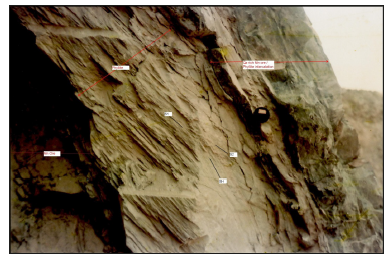
Quartz-muscovite/sericite schists of the peripheral part of the ore bodies at Ramrama, Tirodi Sukli-Sitapathore and at other occurrences comprise quartz, muscovite, microcline and biotite with minor amount of apatite, fibrolite, tourmaline and chlorite. Stretching and recrystallization of quartz and presence of mica fishes are common. Mica appears to be secondary after feldspars. Tourmaline and apatite occur as perfect prismatic crystals, oriented along the pervasive foliation having developed during progressive, ductile to brittle-ductile deformation. Alteration of feldspars to muscovite/ sericite, presence of tourmaline and apatite, and the association of fibrolite and chlorite possibly indicate greisening [15].
The features described above do not support for a sedimentary origin of the manganese ore bodies of this area. The ore bodies are more akin to the hydrothermal bodies emplaced along curvilinear weak zones and stretched and boudinaged where the progressive movement was stronger. At Ramrama, Tirodi and Sukli-Sitapathore occurrences, where country rock is gneissic, progressive shear movement was strong enough to cause such features in the ore zones, rendering the ore bodies into discontinuous lenses. Occurrence of high temperature manganese oxides like hausmanite, vredenburgite, jacobsite and braunite within the low temperature host rock of phyllite and the presence of intergrowth texture can easily be explained once the epigenetic emplacement of the ore bodies is conceived.
Figure 20:Cross cutting relationship of the Mn ore lenses with the host biotite gneiss. Loc. Tirodi Mines.

Figure 21:Bulging of Mn ore bands within wall rock of felspathised biotite gneiss. Please also note the swerving around of the foliation at the periphery of ore lenses. Loc. Tirodi Mines.

Figure 22:Pinching and swelling of Mn ore band within biotite gneiss. Loc. North of Tirodi Mines.
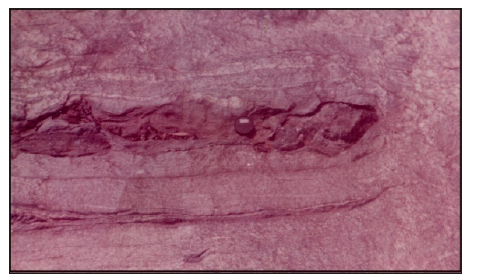
Figure 23:Satellite image showing curvilinear extension of Mn ore bodies from Tirodi to Katangi through Pauniya, Chaukhandi & Chikmara.
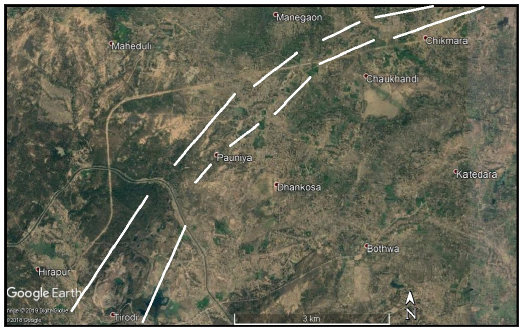
Figure 24:Satellite image showing curvilinear extension of Sukli-Stapathore Mn ore body.
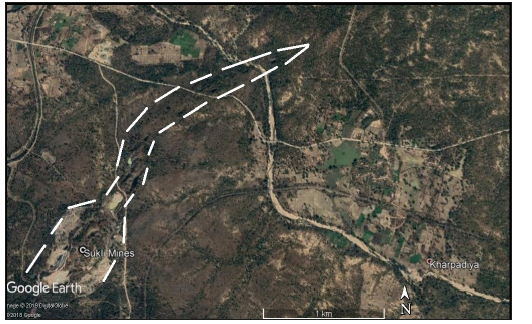
Structural Features
The Sausar rocks are known to have undergone three phases of deformation. Tight, isoclinal to recumbent folding along NE-SW to ENE-WSW axial trend marks the first phase of folding and produces S1 schistosity. The second phase of isoclinal folding is essentially co-axial but non co-planner to F1 folds and produced shallow dipping (300) S2 axial plane cleavages [9]. NW-SE to WNW-ESE trending open warps with steep plunges (700) represent last phase of folding.
Banerji et al. [9], also reported the presence of a series of sinuous mylonite zones in this part of the Sausars (Figure 1). These high strain zones trend parallel to S1 schistosity and have a well-developed mylonitic foliation, parallel to the shear zone boundary. These weak zones represent ductile to semi brittle deformation, evidenced by the alignment of ore/non ore minerals along “S” and “C” surfaces, well within the ore zones (Figure 25), and also by deformation of feldspars by microfracturing (Figure 26). All the major manganese deposits of the area are reported [9,16] to have epigenetically emplaced within these mylonite zones. Development of these weak zones and the associated emplacement of manganese bearing hydrothermal bodies are envisaged to have taken place during late F1 period as the ore bodies and the shear planes exhibit cross cutting (non-co-planner) relationship with the S1 foliation and are deformed along S2 axial traces (Figure 27). This phenomenon is well exemplified in the Bharweli manganese mines. Interference of F2 and F3 folds produce culmination and depression on megascopic scale and deceive for ripple marks on mesoscopic scale (Figure 28).
Figure 25:Alignment of Manganese opaques along ‘S’ and ‘C’ surfaces. Crossed nicols, X32. Loc. Ukwa.

Figure 26:Deformation of feldspar by microfracturing. Crossed nicols, X32 Loc Tirodi.
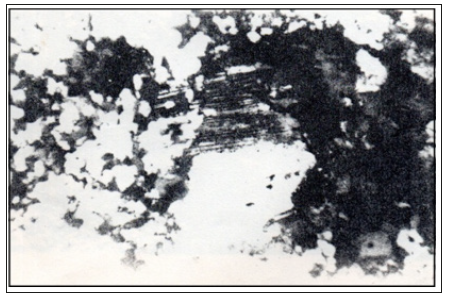
Figure 27:F2 folding of the phyllite/Mn ore intercalations Loc Bharweli.
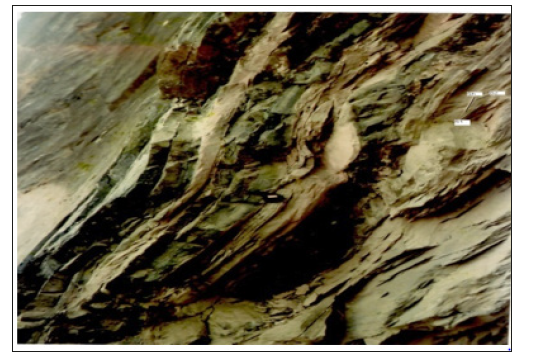
Figure 28:Pseudo ripples produced by interference of F2 and F3 folds on intercalated Mn ore body Loc Bharweli.

Discussion and Conclusion
The rocks of the area represent a metamorphic terrain having synkinematic emplacements of biotite gneiss. The biotite gneisses of the area were earlier classified as Tirodi biotite gneiss forming basement for the metasediments, and the Junewani gneiss representing a metamorphic product of the metasediments. It appears that wherever a gradational contact between the biotite gneiss and the metamorphites were observed, especially adjoining the metasedimentary belt, the surrounding biotite gneiss was considered as Junewani gneiss. The monotonous gneissic body, away from the metamorphic belt contains isolated rafts/lenses of calc-silicates/ granulites and amphibolites. In absence of a correlation between these rafts and the similar rocks present within the cover sediments, the workers probably developed a regional bias to call these far off gneisses as basement gneiss/Tirodi gneiss.
The autoclastic rocks formed within the mylonites passing through the contact between biotite gneiss and metasedimentaries, plays further havoc in considering them as unconformity. Formation of autoclasts is strictly associated with the ductile deformation within these mylonites. The Balaghat-Bharweli-Gangulpara-Jagantola- Ukwa mylonite belt presents development of autoclasts at the phyllite-biotite gneiss contact near Balaghat and Bharweli. However, presence of autoclasts within metacarbonate at Gomji Somji Pahar and at Gangulpara, restricted within the same mylonite, eliminate doubts about their being depositional breaks.
There appears to be a trend of increase in grade of metamorphism away from the central metasedimentary belt. Rate of increase in grade is gradual, especially in the northern part, till complete disappearance of mapable metasediments. This is further low where gneissic body is absent within the metasediments. This has given way to the formation of wide low temperature belt of Mansar phyllite in the eastern part where mapable bands of biotite gneiss are absent. Increase in metamorphic grade is well documented in the associated calc-silicates. Near to the Phyllitic belt, the calc-silicates are hornblende-biotite bearing (lower amphibolite facies), followed by hornblende-zoisite and diopside-hornblende bearing, towards further north. Near the northern end of the metasedimentary belt and to its further north in the main gneissic terrain, the calc silicates are diopside augite bearing, representing highest degree of metamorphism. It is noteworthy to mention that the above narration holds good for the numerously occurring calc-silicate bodies present within Junewani gneiss of the east (Figure 1), where Mansar phyllite grades to biotite schists and with increase in white feldspar bearing quartzo-felspathic bands, grades into biotite gneiss.
Notwithstanding with the above, the major metacarbonate bands present in the western part, though, are located in the medium to high grade zone of metamorphism, as indicated by the floating calc-silicate bodies present in the nearby biotite gneiss, show presence of contact metamorphic assemblages (calcite-dolomite- diopside-forsterite-chondrodite-spinel) along the contact and low temperature assemblages (calcite-dolomite-tremolite-mica/ chlorite) in the core part. Absence of imprints of medium to high temperature regional metamorphism, especially in the core part of metacarbonates is mind boggling. It possibly suggests, that these calc-silicates with variable mineral assemblages are ‘skarns’, developed metasomatically from the carbonates, in accordance with the temperature of the enclosing gneiss. The possibility exists that the regional metamorphism is caused by the synkinematic emplacement of huge mass of biotite gneiss. Development of calc-silicate barriers along the margins of metacarbonates also helped in least penetration of heat to the core part.
The fact that the carbonates dominated over the other sediments of the Sausar Group of the area can be inferred from the omni presence of the carbonates, either as calc-silicates or as metacarbonates. The Mansar phyllite, as such, contains calcite and metamorphic apatite in accessory amount and is associated with several patches of metacarbonates all along its southern margin.
Association of the manganese deposits selectively with the mylonites, their being parallel to the mylonitic foliation and together cutting the S1 plane of the country rock with a steeper dip, and co-folding with S2 and S3 axial traces, points to the fact that the Sausar rocks were affected by co-axial (S1) but non co-planner shearing during the late D1 deformation. These weak planes, during progressive shear movement, were occupied by manganese bearing hydrothermal emplacements, related to late D1 pink feldspar magmatism. Unlike all other sedimentary deposits, the manganese ore bands also penetrate the wall rocks as tongues and apophyses, characteristic of hydrothermal deposits. During progressive ductile movement along these mylonites, the ore minerals got aligned along ‘S’ and ‘C’ planes [9] and even got folded and boudinaged, as in Tirodi and Sukli-Stapthore. This was accompanied by boron metasometism and greisening, producing muscovite-sericite schists in the peripheral part, having enrichment of altered pink feldspars, chlorite, tourmaline, apatite and fibrolite. The mylonites, along with the hydrothermal emplacements/ore bodies, later got affected by D2 and D3 deformations, producing a sinuous map pattern of the mylonites and dome and basin structures respectively.
In conclusion, it is stated that the Sausar rocks of the area do not preserve any sedimentary structure that can ascertain top and bottom of the rocks. The conglomeratic rocks are selectively associated with mylonite zones and are products of autoclastic/ductile deformation. Biotite gneisses are products of synkinematic emplacement of huge mass of white feldspar bearing granitic material within pre-existing, carbonate dominated sediments. The floating masses of older metamorphites/granulites present within the biotite gneiss are ‘skarns’ derived metasomatically from the carbonate rich sediments, and are further granitised to produce the lenses of ‘biotite granulites’, ‘hornblende gneiss’, ‘calc-silicate gneiss’ etc. The variable mineralogy amongst the ‘skarns’ is dependent upon the temperature of the surrounding mass of biotite gneiss. It is obvious that such emplacements will have lesser temperature away from the main mass i.e. well within the metasedimentary terrain, compared to the temperature of the main mass. Thus the diopside-augite bearing ‘skarns’, indicative of a temperature of around 6000C, approximately equal to that of a granite pluton, predominate at the northern end of the metasedimentary belt, and the zoisite bearing ‘skarns’ indicating a temperature of around 4000C, predominate in the southern part, well within the metasedimentary terrain. It is further concluded that all the biotite gneisses of the area have a common intrusive origin. The pink metacarbonates occur invariably associated with pink feldspar pegmatites, and in all probability acquire a pink colouration from pink feldspar felspathization, related to pink feldspar magmatism during late D1 period.
The Sausar rocks of the area, therefore, are the metamorphic products, lacking evidences towards direction of younging, and occurring intricately associated with the synkinematic emplacements, warrant rethinking towards their amenability to stratigraphic hierarchy.
References
- Fermor, LL (1909) The manganese ore deposits of India. Mem Geol Surv 37(4): 613-1287.
- Pascoe EH (1950) A manual of the geology of India and Burma (3rd edn). Vol. 1.
- Narayanaswamy S, Chakravarty SC, Vemban NA, Shukla KD, Subramanyam MR, et al. (1963) The geology and manganese ore deposits of the manganese belt in Madhya Pradesh and adjoining parts of Maharashtra. Bull Geol Surv Ind Ser A 22(1).
- Straczek JA, Narayanaswami S, Subramanyam MR, Dhukla KD, Vemban NA, et al. (1956) Manganese ore deposits of Madhya Pradesh, India. 20th Int Geol Cong, Mexico Session, Symposium on Manganese, Mexico, 4: 63-96.
- Shukla KD, Anandalwar MA (1973) The geology and manganese ore deposits of the manganese belt in Madhya Pradesh and adjoining parts of Maharashtra. Part VIII - The geology and manganese ore deposits of the Balaghat-Ukwa area, Balaghat district, Madhya Pradesh. Bull Geol Surv Ind Ser A Vol. 22.
- Mohanty S (1993) Stratigraphic position of the Tirodi gneiss in the Precambrian Terrane of Central India: Evidence from the Mansar Area, Nagpur District, Maharashtra. Journal Geological Society of India 41: 55-60.
- Subramanyam MR (1972) The geology and manganese ore deposits of the manganese belt in Madhya Pradesh and adjoining parts of Maharashtra. Part IV - The geology and manganese deposits of the Ramrama - Sonawani area, Waraseoni Tehsil, Balaghat district and parts of Seoni Tehsil, Chhindwara district, Madhya Pradesh. Bull Geol Surv Ind Ser A Vol. 22.
- Narayanaswamy S, Venkatesh V (1971) The geology and manganese deposits of northern Bhandara district, Maharashtra. Bull Geol Surv Ind Ser A 22(4).
- Banerji DC, Majumder S, Singhai RK, Shrivastava RK, Fulmari M (2007) Manganese mineralization associated with folded shear zones in Balaghat district, Madhya Pradesh. Jour Eco Geo and Georesource Management 4(1-2): 128-141.
- Banerji DC, Majumder S, Shrivastava R, Fulmari M, Adhir KB (2018) Contact metamorphism of calcareous metasediments of Sausars from Western Balaghat Area of Madhya Pradesh, India and its implication in sausar stratigraphy. Arch & Anthropol Open Acc 3(Suppl-4): AAOA.000567.
- Phadke VA (1990) Genesis of the granitic rocks and status of the Tirodi Biotite Gneiss in relation to metamorphites of the Sausar Group and the regional tectonic setting. Geol Surv Ind Spl Pub 28: 287-302.
- Yardley BWD (1989) An introduction to metamorphic petrology. Longman Earth Science Series.
- Rice JM (1977) Contact metamorphism of impure dolomitic limestone in the Boulder Aureole, Montana. Contributions to mineralogy and petrology. Springer Verlog 59(3): 237-259.
- Thambi PI (1988) Regional exploration for manganese ore deposits in Ramrama-Netra area of Waraseoni Tehsil and Laugur mine sector, Baihar Tehsil, Balaghat district, MP. Geol Surv Ind unpublished progress report.
- Reilly GAO (1992) Petrographic and geochemical evidences for a hypogene origin of granite hosted, vein type Mn mineralisation at the New Ross Mn deposits, Lunenberg country, Nova Scotia, Canada. Econ Geol 87: 1275-1300.
- Banerji DC, Shrivastava RK, Fulmari M, Singhai RK, Devrajan MK, et al. (1996) Final report on special thematic mapping of Sausar belt in parts of Balaghat and Seoni districts of Madhya Pradesh. Geol Surv Ind unpublished progress report.
© 2018 DC Banerji. This is an open access article distributed under the terms of the Creative Commons Attribution License , which permits unrestricted use, distribution, and build upon your work non-commercially.
 a Creative Commons Attribution 4.0 International License. Based on a work at www.crimsonpublishers.com.
Best viewed in
a Creative Commons Attribution 4.0 International License. Based on a work at www.crimsonpublishers.com.
Best viewed in 







.jpg)






























 Editorial Board Registrations
Editorial Board Registrations Submit your Article
Submit your Article Refer a Friend
Refer a Friend Advertise With Us
Advertise With Us
.jpg)






.jpg)














.bmp)
.jpg)
.png)
.jpg)










.jpg)






.png)

.png)



.png)






